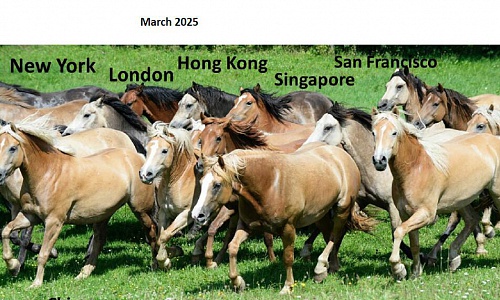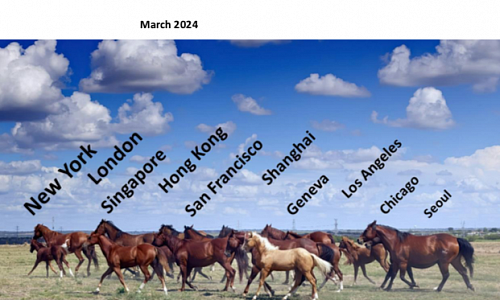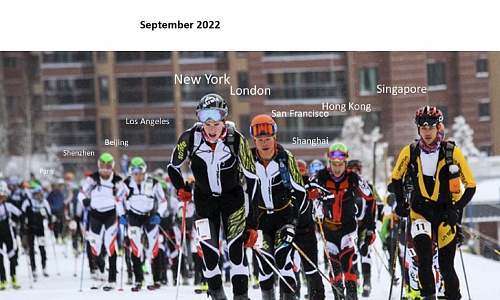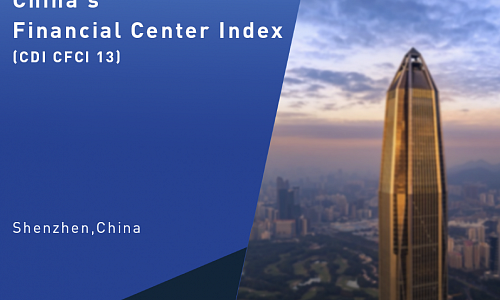
2023 - Insights

Date: Dec 7, 2023
Authors: XIE Laifeng1, TAN Huifang2, ZHUANG Zhuohao3, and MO Dilang3
Due to the unique “One Country, Two Systems” framework, institutional innovation that facilitates the free flow of production factors strengthens inter-governmental cooperation and promotes the cooperative development of the economy and industries has become key to advancing the construction of the Guangdong–Hong Kong–Macao Greater Bay Area (GBA). Within the GBA, Guangzhou and Hong Kong’s success in cross-border equine industry cooperation has been empowered by the two cities’ continuous exploration of institutional innovation. This article systematically examines their experiences and presents policy improvement suggestions based on the future development needs of the cross-border equine industry.
In support of the equestrian events of the Guangzhou 2010 Asian Games, the construction of the equestrian venue and the establishment of the country’s first equine disease-free zone (EDFZ), which was certified by the World Organisation for Animal Health and the European Union, was completed in Conghua District, Guangzhou. Following the Asian Games, to maximize the usage of existing resources and facilities, the Guangzhou municipal government introduced the Hong Kong Jockey Club (HKJC) to Conghua, which later converted the equestrian venue into the Conghua Racecourse. In August 2018, The HKJC Conghua Racecourse officially opened for operation, becoming Mainland's first racecourse and thoroughbred horse training center to meet international standards. As the equine industry cooperation between Guangzhou and Hong Kong deepened, the two cities signed the Co-operation Agreement between Guangdong and Hong Kong on Equine Industry Development in May 2021, and since have steadily advanced major projects such as an international horse-trading platform and international equestrian sports events.
After examining the cooperation process within the Guangzhou–Hong Kong equine industry, it became evident that amidst the development of the GBA, some of the regulatory measures presented challenges that hindered the cross-border flow of production factors between Hong Kong and the Mainland which was fundamental for further industrial development. Therefore, governmental-level institutional innovation became imperative. The institutional innovation in the Guangdong–Hong Kong equine industry cooperation is illustrated in the following four areas.
First, regarding government cooperation mechanisms, designated task force and leadership groups were created. The Guangdong–Hong Kong Equine Industry Cooperation Task Force, established under the Hong Kong/Guangdong Co-operation Joint Conference mechanism, can collaboratively plan the coordinated development of the equine industry in the GBA at a higher level and serve as an important medium in addressing challenges that emerged during the development process in a targeted manner. Additionally, the task force promotes exchanges among relevant enterprises, institutions, and personnel between the two locations. Guided by the task force, Guangzhou and Conghua have each established leadership groups for the equine industry, collaboratively advancing the implementation of various initiatives for the development of the Guangzhou–Hong Kong equine industry.
Second, in terms of customs clearance, the introduction of the “one-time approval, multiple round trips” registration and filing system, which allows horses multiple entries and exits to Guangzhou during a validity period, has created a new model for cross-border horse transportation within the GBA. Furthermore, the exchange of horses between the two locations is safeguarded by the establishment of unified inspection standards and a recognition mechanism for inspection and quarantine testing results. Lastly, Guangzhou Customs has established a dedicated office at the Conghua Racecourse to implement biosecurity surveillance and controls to guarantee the security of the EDFZ and cross-border horse transportation.
Third, the collaborative effort of Hong Kong’s Agriculture, Fisheries and Conservation Department and mainland authorities, including Customs, Ministry of Agriculture and Rural Affairs, and provincial, municipal, and district governments, was fundamental to the pioneering establishment of an EDFZ that spans the entire Conghua District and the innovative inclusion of a biosafety highway that enables the direct transfer of horses between Conghua and Hong Kong.
Fourth, the Guangzhou municipal government has delegated foreigner visa issuance to Conghua, allowing foreign employees of HKJC to apply for visas nearby. With the assistance of the Guangzhou Municipality, the children of non-Guangzhou Hukou talents employed by the HKJC who meet the prescribed conditions can enroll with their nearest compulsory education provider without taking entrance exams.
The equine industry cooperation between Guangzhou and Hong Kong has yielded fruitful results; however, to maximize cooperation in the cross-border equine industry chain, both Guangzhou and Hong Kong must continue to explore more substantial institutional innovations.
Firstly, increased facilitation to smooth the movement of horses and clearance of associated goods is needed. Examples include streamlining the clearance process, establishing a normalized emergency response mechanism, and establishing dedicated control stations at both the origin and destination points of cross-border horse transportation routes.
Secondly, to facilitate the international horse-trading platform and international equestrian events, proactive policy arrangements should be made so registered foreign veterinarians can provide veterinary services in Guangzhou and Conghua.
Thirdly, further research into creating a mechanism that promotes international mutual recognition of inspection and quarantine findings is needed to allow foreign horses to transit the Conghua EDFZ which is critical for hosting international equestrian events.
Lastly, introducing and nurturing talent in the equine industry is vital. It is recommended that to strengthen talent training in the equine industry further, support be provided to relevant universities to build faculties focused on the modern equine industry. Additionally, the facilitation of HKJC’s foreign employees working and living in Guangzhou should be continued, professional qualifications recognition be supported, and industry professionals be enabled to enjoy preferential personal income tax policies within the GBA.
---------------------------
- Deputy Director, Department of Hong Kong, Macao and Regional Development, CDI
- Lecturer, School of Economics and Management, Xiangnan University
- Project Research Fellow, Department of Hong Kong, Macao and Regional Development, CDI

Date: August 21, 2023
Author: Dr. LI Enhan and Ms. ZHUO Shengling, China Token Digital Economic Research Center, CDI
When discussing the rapid advancement of artificial intelligence, it undoubtedly marks the dawn of a new era in technology. It is set to become a key force driving a new wave of technological revolution and industrial transformation. Shenzhen has released a corresponding action plan and the initial roster of "City + AI" application scenarios, while also establishing a substantial 100 billion CNY fund dedicated to artificial intelligence.
Overview of the global competition in artificial intelligence
On a global scale, the competition in artificial intelligence has become a pivotal area where countries vie for dominance. Leading technological powers like the United States, the European Union, and China continue to intensify their investments and strategic positioning in the AI domain.
The United States stands out for its strategic leadership, substantial capital support, and technological edge. Consistently investing in policies and research in AI, it aims to retain its global leadership. In recent years, the U.S. has introduced a series of significant policy documents, emphasizing funding particularly in technological applications in national defense.
The European Union prioritizes safeguarding fundamental rights and leads the way in establishing regulatory frameworks for artificial intelligence. Its focus lies in preventing technological development from potential erosion of human rights, exploring the establishment of a regulatory system, and ensuring the safety of artificial intelligence technology and applications within the EU. Additionally, Europe holds significant advantages in applying AI technology to manufacturing and industrial automation.
With abundant data resources, robust technological foundations, and strong policy support, China's AI industry thrives, unveiling innovative application scenarios continuously. China has also shifted its policy focus from industrial development towards technological regulation and governance, emphasizing the balance between technological oversight and industrial growth. Moreover, it actively publishes ethical guidelines and policy documents to ensure that the advancement of artificial intelligence does not compromise national security or societal order.
The development of the artificial intelligence industry in China’s major cities
Major cities in China are actively exploring various initiatives to become leaders in global AI development, each following its unique development path.
Beijing, leveraging its vast talent pool, outstanding technical prowess, and innovative atmosphere, has issued multiple policies to encourage the development of the AI industry, striving to build itself as an innovation hub for AI.
Shanghai, with a primary advantage in application-driven innovation, extensively applies AI technology across economic, societal, and governance domains within its digital transformation efforts, and strives to create an artificial intelligence “Shanghai hub”.
Shenzhen aims to become a significant player in the global AI arena. The city government has introduced numerous policies and plans while establishing a 100 billion CNY AI fund to foster a comprehensive development environment. Supported by the electronics and information industry, Shenzhen focuses on breakthroughs in core technologies, accelerating the introduction and development of key industries, and attracting numerous enterprises to enter various levels of the artificial intelligence industrial chain.
Next steps for Shenzhen
Shenzhen's future in AI development will center around three core directions. Firstly, there's a push for a deeper integration of artificial intelligence technology with the real economy, especially the industrial manufacturing. This involves adhering to the objective laws of technological development and steering clear of excessive exaggeration or speculative practices. The focus should be on strengthening collaborative innovation between foundational research and industrial applications. Additionally, there's a drive to integrate AI technology with infrastructure construction. It's vital to leverage industrial funds as well, ensuring continuous updates and iterations to expedite technological maturity.
Secondly, effectively leveraging both market initiative and government guidance is critical. Shenzhen's market-oriented environment, exceptional business atmosphere, and favorable policies are vital to spark innovation among market entities in artificial intelligence. At the market level, it is imperative to give full play of the advantages brought by major enterprises and platforms in terms of technology, data, and integrated ecosystems. Regarding the government’s role, there should be continual increments in investments in new infrastructure, orderly progression in open sharing of public data, and exploration of cross-border data circulation between Shenzhen and Hong Kong.
Ultimately, the crux of advancing artificial intelligence lies in finding a balance between innovation and security. This entails ensuring the safety and sustainability of AI innovation through three primary aspects: rigorous compliance with pertinent legal regulations, emphasis on integrated development, and exploration of ethical standards alongside policy frameworks.

Date: Dec 28, 2023
Author: Dr. Yu Zongliang, Director, Research Center for Free Trade and Innovation, CDI
The Guangdong–Hong Kong–Macao Greater Bay Area (GBA) is among China’s most open, economically agile, and business-friendly regions. As of 2022, the GBA's GDP was approximately CNY 13.04 trillion, with a per capita GDP of approximately CNY 150,900. Despite occupying less than 1% of China's land area and being the home of only 5% of its population, the region contributes 11% of the nation's total economic output. In December 2023, the National Development and Reform Commission (NDRC) of China unveiled an action plan to further enhance the GBA's business environment.
Various domestic and international business environment rankings indicate that a better business environment correlates with greater economic prosperity. Therefore, a conducive business environment is crucial for promoting prosperity at the national, regional, and city levels, and serves as a key aspect of economic competitiveness. Enhancing the business environment in the GBA will support the creation of a first-class bay area and world-class city cluster that is dynamic and internationally competitive.
At the micro-level, the action plan revolves around effectively serving and enhancing the sense of growth and satisfaction among businesses by considering their complete lifecycles. This includes encompassing every stage of their development, reducing institutional costs, and ultimately benefitting the public.
From a reform perspective, the action plan highlights the transformation of government functions. The reform and innovation of internal systems and mechanisms fall under the umbrella of constructing a supportive environment within the superstructure.
By integrating advanced concepts and experiences globally, the GBA aims to establish a business environment system that aligns with international standards and achieves a world-class level of marketization, rule of law, and internationalization. Market connectivity levels will significantly improve, enabling the region to attract and allocate more global resources.
To achieve these goals, it is crucial to properly manage the following six relationships.
First is the relationship between the government, the market, and society. The construction of a favorable business environment entails collaborative efforts among diverse entities, such as the government, the market, and society, rather than unilateral actions by the government. Subsequently, the action plan includes aspects concerning social organizations, diversified dispute resolution mechanisms, and credit-building.
Second is the relationship between innovation and replication. Specifically, the various reform measures targeting the business environment are aimed at producing institutional innovations that can be replicated, rather than providing long-term exclusive policies for the few cities.
Third is the relationship between micro-reform and systematically integrated innovation. The action plan emphasizes locating and addressing the most pressing concerns of local people, even if small, then enabling an incremental and rapid progression of systematic initiatives to develop a better business environment.
Fourth is the relationship between local innovation and central facilitation. Coordination of top-level design with grassroots exploration is essential to fostering regional initiatives. The local grassroots level is closer to the market and is better informed and more up-to-date regarding the specific needs of local business entities. Therefore, the local level should be granted greater autonomy to boost reform and innovation.
Fifth is the relationship between policy and legal support. A clear and credible legal environment, in which the security of property and transactions is guaranteed, will enhance investors’ confidence and willingness to invest in and promote the market. Thus, it is necessary to promptly and effectively promote the establishment, modification, and interpretation of relevant laws, regulations, and rules to ensure the legality of reforms. This will also enhance the predictability and certainty of business environment reforms.
Last is the relationship between Hong Kong, Macao, and the nine mainland cities within the GBA. The GBA is unique, with its "one country, two systems", three customs territories, three legal systems, and three currencies, and requires Hong Kong, Macao, the mainland cities, and the central government to collaboratively promote market integration within it. This consists of compliance with international economic and trade rules and breaking the reliance on past practices of opening borders between Hong Kong, Macao and the Mainland.

Date: Nov 23, 2023
During a recent interview, Prof. FAN Gang, President of China Development Institute, provided perspectives on the development of large enterprises, insights on the importance of fostering private enterprises and how China should navigate through the economic challenges that it faces now.
Synergies and Challenges in Diverse Business Scales
Businesses of all scales have the opportunity to innovate in a variety of ways. While small businesses may specialize in specific technological fields, they often struggle to achieve systematic technological development. On the other hand, large enterprises tend to integrate multiple technologies to create more comprehensive products. The large enterprises play a distinct and pivotal role in economic modernization especially within the innovation ecosystem, as they are able to catalyze a network of SMEs and integrate them into the innovation chain.
Furthermore, thanks to their ample capital and profits, large enterprises are able to make long-term, sustained investments into R&D, thereby propelling systematic and continuous innovation in fields like cloud technology and AI. Nevertheless, the key lies in establishing oligopolistic competition within the industry structure while averting monopolization, and ensuring ample space for innovation for SMEs.
Nurturing Private Enterprises for Economic Progress
When comparing China's private enterprises with state-owned enterprises (SOEs), significant differences exist. It is crucial to focus on the development of private enterprises as they are critical to China’s economic growth.
State-owned enterprises, due to their close ties with the government and other entities alike, exhibit weaker independence. Moreover, they operate under stringent institutional frameworks and scrutiny in decision-making, necessitating cautious consideration for the use of public funds and risk mitigation, thereby limiting their investment in innovation and capacity in risk-taking. In contrast, private enterprises are more responsive to market signals, showcasing greater flexibility and advancement in innovation. Meanwhile with their own capital at stake, the private enterprises bear the consequences and potential losses of taking risks to invest in innovation, which in turn brings stronger impetus for success. Therefore, in a market economy, private enterprises exhibit exceptional performance, particularly in high-tech industries.
Despite their significant role in the economy, large enterprises often face disadvantages in the market competition, especially with respect to financing, market access, and policy support. It is important to take a dialectical view of these realities and not adopt policies to suppress private enterprises. The future of China's economy lies in fair policies and programs that foster the development of private enterprises rather than transforming them into SOEs.
Navigating Through the Economic Challenges: Insights and Prospects
The biggest economic challenge that China faces at the moment is the insufficient demand which has led to a slowdown in economic growth. This situation is not the result of a single factor, but stems from multiple causes such as the impact of the pandemic on the industrial chain, unemployment and decreased expectations for income growth. However, stimulating demand has become particularly difficult in the current economic cycle. Hence, adept management during economic downturns is crucial for China. The government plays a key role in boosting demand, especially when private demand is insufficient, and government demand can serve as a supplement. Yet, inadequate future expectations among businesses and residents are also significant contributors to weak demands. Under such circumstances, the government should take more targeted measures to invigorate overall demand rather than just stimulate consumption. Addressing these challenges requires government wisdom and strategies to effectively manage cyclical economic fluctuations, and more importantly to guide the economy safely through downturns.
As for the future of the Chinese economy, international opinion suggests China might echo Japan's "lost 30 years". However, differences emerge when comparing the two, such as China’s current urbanization rate and overall economic development, and that of Japan in 1991. Japan was already a highly developed economy in 1991 with an urbanization rate of 77.4%, while China is currently at 65.4%. Therefore, China is still in a relatively stable growth phase rather than a continuous decline. Additionally, in terms of government debt ratios, the total debt ratios of China's central and local governments are similar to those of Japan's in those years, but China has huge amount of state-owned assets and a lower gearing ratio, which will provide more room to boost the economy once state-owned assets are utilized. Last but not least, the vigilance of China towards debt risks in both the financial and residential sectors far surpasses that of Japan during the corresponding period.
As a developing country, short-term economic fluctuations are normal. Although China is currently experiencing a downturn, it doesn't indicate the start of a long-term slump but is most likely a short-term fluctuation.








